x86 CPU frequency and power steering with Sculpt 23.10
With Sculpt 23.10 the previous sneak peek feature got integrated into the Genode base framework and hence is readily available with the new Sculpt OS release.
Intro
As described in the previous sneak peek article, CPU vendors provide features for the operating system to influence frequency and power consumption, like Intel HWP or AMD pstate to name just some of them. Some of the features require at the lowest level access to selected MSR CPU registers, which can solely by accessed by privileged rdmsr/wrmsr instructions available to the kernel.
With this release we add the general support to the Genode base framework, to add guarded access to selected MSRs via Genode's system_control RPC of the protection domain (PD) session. If the underlying kernel supports this feature, as now done for the NOVA kernel, read and write requests are forwarded by Genode's roottask to the kernel. A component needs the explicit "managing_system" Genode configuration permission to get access to this functionality, which is by default not granted.
The MSR component is an component using the Pd::system_control interface, with which it monitors and reports changes of registers for temperature and frequency (AMD & Intel) and power consumption (Intel). Additionally, the component can be instructed by configuration changes to write some of the registers. Beside the quite low level MSR component, a Genode package with an additional graphical component is provided to make the interactive usage of the feature user friendly. All sources and package recipes are available via my github repository.
Usage
Two MSR packages, one with and without GUI, are provided via the alex-ab depot.
After enabling the alex-ab depot via
+
-> Depot
-> Selection
-> alex-ab
one can choose one of the two packages to be installed:
+
-> Depot
-> alex-ab
-> CPU frequency and temperature (Intel and AMD)
-> msr tool (with GUI)
-> msr tool (no GUI)
During configuration, the resource dialog must be selected and the permission "System control" must be granted so that the packages can operate properly, as described before in the introduction.
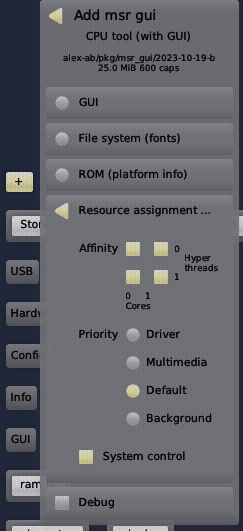
|
If the extra permission got forgotten, the packages will complain, e.g.:
[init -> runtime -> msr] Error: - CPU or used kernel misses MSR access support [init -> runtime -> msr] Error: - and/or missing 'managing_system' configuration
After the first successful start, the tool will show all CPUs with their current frequency and temperature.
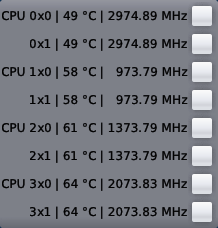
|
By choosing the button left of the CPUs, the settings menu can be opened and closed:

|
In the menu you can change the update frequency of the tool with right/left mouse clicks on the number buttons. If Intel HWP is still off, (if disabled in /boot/grub/grub.cfg), you may enable it once. According to the Intel specification, it can't be disabled afterwards until reset. In the normal settings mode, you can choose between performance, balanced and power-saving mode. Your changes will be effective as soon as you press the apply to all CPUs button at the bottom. If the CPU supports Intel Running Average Power Limit Energy Reporting technology, the power consumption for various domains will be shown.
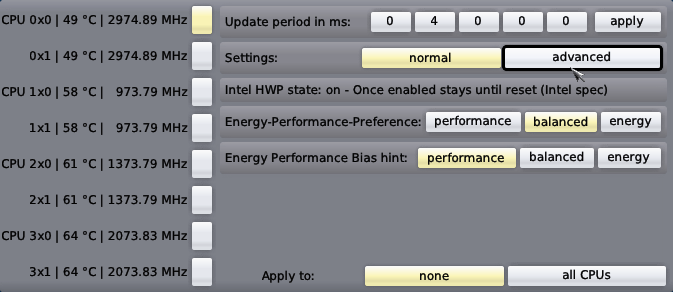
|
Additionally, you may enable the advanced settings mode, where more details are shown and accessible by toggling the custom buttons. In the advanced mode you may also apply your changes per CPU instead of applying it to all CPUs at once. The advanced mode differs between Intel and AMD, because the MSRs are not standardized (beside the frequency monitoring).
Intel:
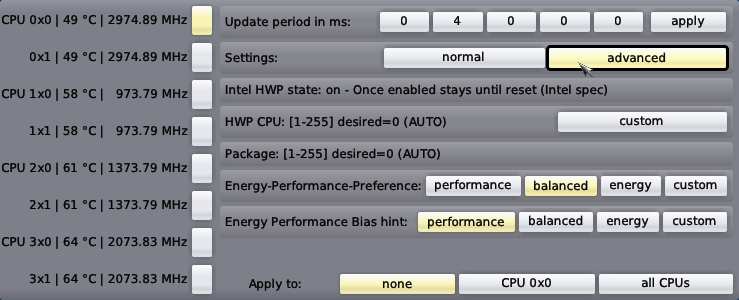
|
AMD:
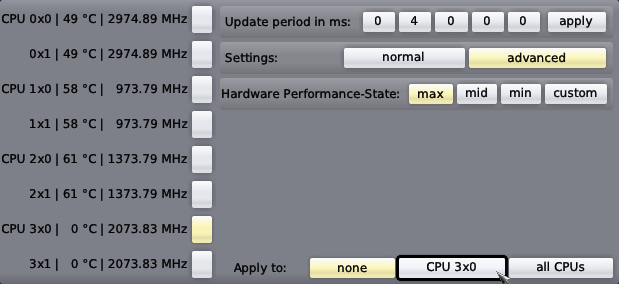
|
When selecting the custom button, you may change even the values in the range as specified by the CPUs. For details, at the moment, one have to read the AMD and Intel specification, which is left to the advanced user as exercise ...
Happy tuning !


 Alexander Böttcher
Alexander Böttcher